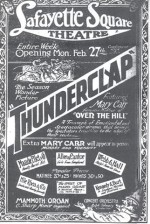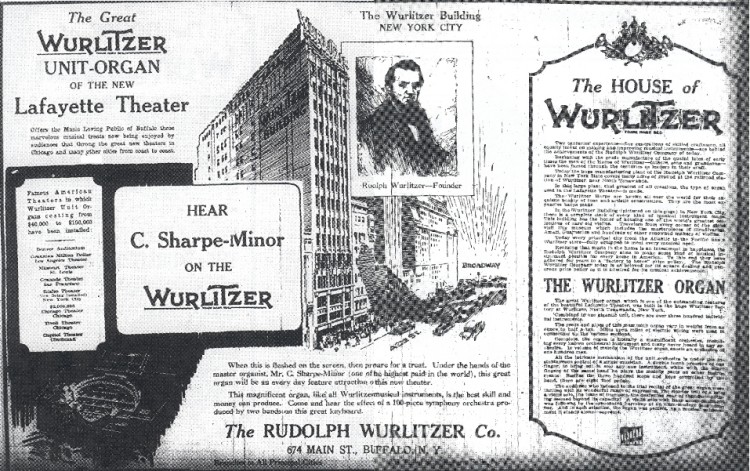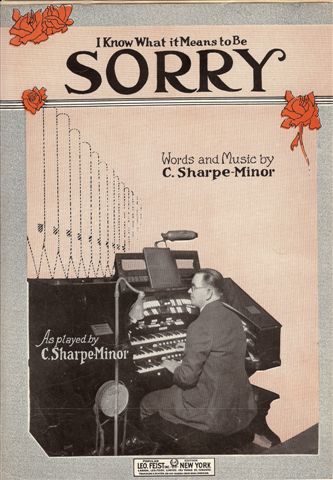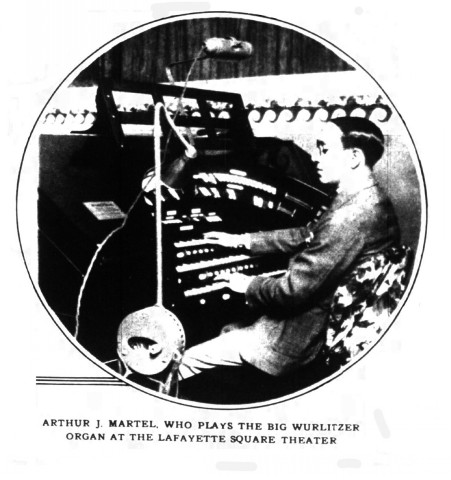1922-1962
WurliTzer Opus 501 was installed in 1922 in the Lafayette Square Theatre located in Buffalo, New York. The theatre's grand opening was held on Monday, February 27, 1922, and “The Buffalo Evening News” contained the following article about the theatre and the organ on that day. (Many thanks to John Basil, whose family owned Basil's Lafayette Theatre from 1942 until 1962, for supplying this historical information through reprints of the newspaper articles and also from his yet unpublished book entitled "True Theatre History During The 20th Century.")
Lafayette Square, Buffalo’s New Theatre, Opens Tonight
Mary Carr, Famous for Her Mother Role in ‘Over the Hill,’
Will Appear in Person
"Buffalo’s newest and biggest movie palace, the Lafayette Square theater, will open this evening. Indications are that it will be filled to capacity. Workman today were busy putting the final touches on this luxurious temple for the entertainment of the public.
A special program will be offered tonight. Mary Carr, famous as the film star who played the endearing role of the mother in “Over the Hill,” will be seen in person. Several movie magnates are also scheduled to be present.
The picture features of the program will be “Thunderclap” in which Mary Carr is the star. This is described as an emotional and spectacular drama. There will also be half a dozen vaudeville acts which will show theatergoers the kind of policy on which the playhouse will be operated in the future.
Buffalonians will have opportunity of hearing for the first time C. Sharpe Minor, as organist of widespread reputation on the Pacific coast, who has been brought to this city under contract to play. He will give a recital on the Wurlitzer Hope-Jones Organ, said to be one of the most remarkable pipe organs ever constructed. The concert orchestra under the direction of Ralph Schwartz will present a special program.
The theatre seats 4200 and is designed to provide all the latest appliances for the comfort and convenience of patrons. The general color scheme throughout is gray, with pleasing combinations of buffs and rose. Handsome mural paintings adorn the walls. The ceiling is finished in a dome effect with rich ornamental work and decorations, and from it are suspended five magnificent crystal chandeliers.
A grand staircase leads to the mezzanine floor. It is in marble. There are commodious smoking and lounge rooms.”

Fig. 1: This advertisement
appeared with this article
The February 26, 1922, edition of “The Buffalo Sunday Times” included the following article about the organ: (Please note that this article was copied as published; however, it appears that some information may have been omitted, particularly toward the end of the article.)
New Wurlitzer Organ Installed
"After two centuries of experience, five generations of skilled craftsmen, all equally intent on making and improving instruments, are behind the achievements of the Rudolph Wurlitzer Company of today. An excellent instrument, a finished product of the Wurlitzer Company has been installed in the new Lafayette Square Theater, which opens to the public on Monday evening. Management of the new Lafayette Square Theater has purchased a Wurlitzer Hope-Jones Unit organ.
It excels in volume, variety, and delicacy of tone color. The ponderous tones of the might diaphones and the tubas, while capable of producing thunderous volume, can be reduced in power by means of the swell shades, so as to accompany human voice.
Fathers, sons and grandsons of the Wurlitzer house have devoted their lives in producing an instrument that stands the test, an instrument that has won fame through the centuries. The Wurlitzer organ can be called a home product as it is manufactured in North Tonawanda. The greatest of all creations, the type of organ that was installed in the new Lafayette is made in North Tonawanda.
Music in the home is an investment in happiness. To promulgate this idea the Rudolph Wurlitzer Company is aiming to make some kind of musical instrument that can be found in every home. The generous price policy, square and fair business methods have won admiration for the Rudolph Wurlitzer Company.
The tone quality of the Wurlitzer hope-Jones unit organ is so majestic and refined that it thrills the listened and holds him spellbound in wonder and amusement at the wealth of tone color furnished. The delicate strings are the nearest approach to the violin yet accomplished and are superbly rich in tone quality. The flutes, clarinets, oboes are realistic imitations of these instruments, while the diapasons furnish the rich deep and sonorous tone which forms the backbone of the king of instruments.
The mighty tubas and diaphones are a revelation in the art of organ voicing, furnishing a wealth of tone color which can only be realized by listening to them. In addition, there are a number of new tone colors only to be found in the Wurlitzer Hope-Jones instruments, which greatly add to the variety of tone usually in the organs. The whole instrument, with the exception of the 32 feet pedal diaphones and piano, in enclosed in two specially built chambers so that every stop is capable of expression at the will of the performer. To try and convey to the listener the vastness of the size of the large 32-foot diaphone, CCCC pipe is 34 inches square at the large end, tapering down to a 6-inch square, and is 32 feet in length. In contrast to this, the speaking length of the smallest pipe in the organ is about ¾ inch and of the diameter of a straw, and weighs but 1-2 ounce.
In addition to the grand and dignified tones associated with the pipe organ, this instrument contains a great many percussion effects, such as: Harps, chimes, xylophones, glockenspiels, vibrating bells, sleigh bells and drums. It reproduces in a lifelike manner the symphony orchestra with a pipe organ. The wind pressure employed ranges from 6 to 18 inches. The use of heavy wind pressures and up-to-date methods of voicing produce quality and volume of tone absolutely impossible of production by the ordinary means. The Wurlitzer Hope-Jones electro-automatic action is absolutely reliable as it has stood the test of time, having been in use over 20 years. The touch of the instrument is lighter than that of a piano, and no matter how much or how little the organ is used, the touch remains uniform. It is capable of repetition far quicker than any performer can execute. This is fitted to the accompaniment, great, and bombarde organs and is a wonderful help to the player as it enables him to bring out any particular part or solo without raising his hands from the keys. The second touch is also fitted to the pedal organ for use in connection with the drums. For sforzando effect, this device is most useful.
This unique attachment is fitted to tow keyboards and pedal, with wonderful results. Such effects as a violinist plucking the strings of his violin are possible by means of this addition. Three of the keyboards are fitted with this device, which enables the player to have a suitable bass arrangement for him at all times, and under all conditions. By depressing a tablet, which is placed under each keyboard, a suitable bass is automatically provided to whatever stops are drawn on the manuals, and by a further depression of the tablet, the mechanism is what is termed “locked” and as the stops or combinations are altered, the bass stops or combinations, automatically alter to suit.
Playable from and attached to the organ console by means of an electric cable so that the organist can play piano from the console with as expression as if he were seated at the piano itself. This is accomplished by means of the different key touches in conjunction with special expression devices and the result achieved is a revelation. The expression obtainable though the medium of the swell shades fitted our patented sound trap joint is truly remarkable, and cannot be equaled by any other form of swell shades.
The console is a wonderful piece of workmanship and the materials used in it manufacture are the very finest that can be obtained. It is semi-circular in shape, thus affording to the organist greater facility for the manipulation of all the parts. There are three keyboards and pedal board, 128 stop keys, 48 pistons, and aids to assist the organist in the playing of the instrument. The casework of the console is of polished mahogany beautifully finished. Over 200 miles of wire have been consumed in giving the organist control of the various parts. One electric motor of ten horse power is required to drive the blower that furnishes the wind for this mammoth instrument.”

This advertisement for the WurliTzer Company appeared with the article about Opus 501
Update August 31, 2022: After more than a decade, it has finally been verified that the picture directly below does show the organist C. Sharpe-Minor seated at Opus 501 when it was installed in the Lafayette Theatre, Buffalo, NY. That picture is on the cover of a piece of sheet music titled "I Know What It Means To Be Sorry" which was written by Sharpe-Minor and copyrighted in 1923. Mr. Sharpe-Minor was the first organist to play Opus 501 at the Lafayette Theatre in 1922, and he remained associated with the theatre until 1927. Many thanks to Dr. William L. Coale, author of a series of books about the famous theatre organist George Wright ("The Genius of George Wright"). For the 100th anniversary of Opus 501, Dr. Coale graciously provided us with a number of files pertaining to historic articles about the Lafayette Theatre and Opus 501. A picture in one of those files (shown below under the C. Sharpe-Minor sheet music picture) shows Arthur J. Martel, who also played Opus 501 at the Lafayette Theatre. Both pictures show the same light with an unusual circular object attached to the light stand, verifying that the C. Sharpe-Minor picture was taken at Opus 501.


  
| 
